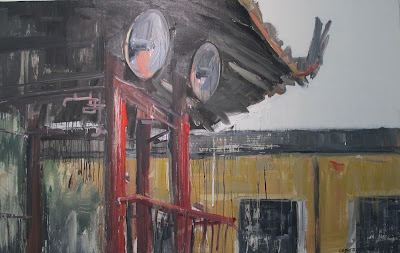 |
| Inside Dashanzi Art District, Beijing - relics of the industrial past |
I write this at the end of my third day in Beijing. A day as exhausting, exhilarating, frustrating and wonderful as this one has been could only happen in China. I had arranged an interview with a young artist, a meeting at the Three Shadows Photography Art Centre and visits to four galleries, all in Caochangdi, which sounds like a manageable schedule but didn't really take into account the particular difficulties of getting around. Caochangdi (an outlying place, part city, part old town, part ugly suburb) is notoriously difficult to navigate and tends to involve many, many phone calls in Chinese to the various parties asking how the hell to find them. Taxi drivers patiently drive in circles, sometimes stopping in the middle of the road and turning off the engine while the phone calls are made.
With Stanley, my trusty translator, I caught the bus. He assured me he knew where we were going. After leading me up onto a railway track, where we were followed by mangy and quite possibly rabid dogs, I decided the hell with his 'face' and said, 'Oh really, I don't think so - call the gallery now!' Many phone calls ensued, and we walked first one way, still followed by the dogs, then another, down dusty windswept streets. Past an elementary school with military marching music blaring from loudspeakers and little children in blue tracksuits exercising in the yard, past street markets with underpants and running shoes laid out on the trays of rusty old tricycles and vendors selling what appear to be grilled intestines on sticks, past factories, construction sites and military barracks. I wonder, as I do so often in China, why villages in the countryside and many parts of Beijing look as if they have somehow survived the apocalypse.
Eventually, many shouted Chinese phone calls later, it transpired that we had passed the entrance to the street several times in our wanderings.To get to it we had to duck underneath an advertising hoarding and wend our way past an enormous and hideous KTV karaoke parlour set in a kind of wasteland with Egyptian statuary and what looked like a sculpture of the four horsemen of the apocalypse out the front. Quite appropriate. Then suddenly we are in a tiny narrow walled lane and emerge into the series of beautiful galleries designed by Ai Weiwei some years ago, before his current troubles.
 |
| Urs Meile Gallery, Caochangdi, Beijing |
 |
| Zhou Yilun, 'Beijing Hao Gan A' (Beijing is very dry) installation view at Platform China |
 |
| Shao Fan, Chicken Wing Bone, 2010, oil on canvas |
I met young photographer Chu Haina at Egg Gallery where she is currently showing her work in a group exhibition, and we spoke at length about her practice. She creates blurry, soft and very ambiguous images shot with film and printed digitally. Her work reminded me of early photographs by Niepce or Daguerre, or experiments with alternative processing. She is self taught, and very dedicated, living in a space in Caochangdi tinier than any I have ever seen. Having shown her work in an exhibition of emerging artists at Redgate Gallery, and now at Egg Gallery, she is hoping for a solo show. This seems to be the right time for young photomedia artists in China, with increased interest in its possibilities for making images which reflect contemporary life. Haina takes her camera everywhere she goes and looks for images which will evoke a particular kind of feeling in the viewer. She herself loves an eclectic range of artists, from Diane Arbus to Taiwanese photographer Ruan Yizhong to the Japanese Hiroshi Sugimoto, who was shown at Pace Beijing earlier this year. Her work has an elegiac and subtle quality, especially the larger more abstract prints shown at Redgate.
 |
| Chu Haina with her work at Egg Gallery, Beijing. Photograph Luise Guest, reproduced with permission of the artist |
 |
| Three Shadows Photography Art Centre, Caochangdi |
 |
| Works by Kang Wanhua shown at Boers-Li Gallery Beijing |
Other interesting work seen today:
An installation created from spent fire crackers by Jiang Zhi:
 |
 |
| Jiang Zhi, The Quiet Bodies |
Variations on the tradition of papercutting, 'Strange Flowers' by Hoyun Shin:
Elegant meditations by Shen Kelun on traditions of Chinese furniture and lacquer ware:
A series of fabulously expressionist paintings by Cui Guotai that are like a lost lament to the heroic workers and heavy industry of the Communist past:
 |










